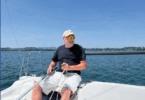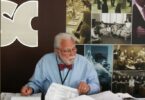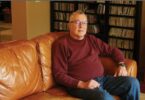

PAC World: When and where were you born?
J.A.: I was born in Irun, Basque country, in Spain in 1954.
PAC World: Where did you grow up and where did you go to school?
J.A.: I grew up in my birthplace. It is a bay between beautiful beaches and green mountains, which is the border between Spain and France. On the French side of the bay is Hendaye and opposite it is the medieval walled town of Hondarribia and Irun. I studied at Colegio San Marcial of De La Salle Brothers, where discipline was a fundamental value. Given the location on the border, the second language at school was French.

PAC World: Did you have any specific interests while in school?
J.A.: I was a good student. I did not have a special interest in mathematics, which seemed too abstract to me. However, I loved physics and the way of describing physical phenomena using mathematical equations.
PAC World: Can you think of someone or something in your childhood that influenced your decision to become an engineer?
J.A.: At 10 years of age, I was in a vocational training school. I intended to become a technician worker in a factory. One day, some teachers suggested to my parents that I move to a secondary school to be able to go to university. From that day, I knew I would be an engineer.
PAC World: Where did you go to university and why did you choose that one?
J.A: I studied engineering in San Sebastian, which is 20 km from home and was the most logical and economical option.
PAC World: Why did you study electrical engineering?
J.A.: In those years, my father had a hobby of fixing old valve radios. This sparked my curiosity for electronics. On my first attempt to fix a radio, a huge electrolytic capacitor exploded and the whole room filled with smoke. It was my first experience with severe electrical faults.
PAC World: Did you study power system protection?
J.A: Not specifically, although my graduation thesis was about instrument transformers.
PAC World: Did you have any other interests besides learning at that time?
J.A.: I loved reading, biking, hiking, and spending time with friends. We were a group of more than 20 boys and girls. We had a lot of activities and fun, especially in the summer.

PAC World: How and where did you start your career?
J.A.: After some temporary jobs, in 1978 I started working in Bilbao for Iberdrola in computer hardware maintenance for the Transmission Network. First, I followed an 8 month training course on computers in Houston, TX at TRW. Then, I spent 7 years working on the new project on the automation of the transmission system.
PAC World: What were your responsibilities while you were there?
J.A.: My responsibilities included the entire hardware of the SCADA system including central real time computers (Modcomp IV) and RTUs. The technology was before microprocessor introduction, based on TTL integrated circuits and magnetic core memory. My role involved troubleshooting computer failures at the chip level, often dealing with intermittent issues. Finding the root cause of such faults was quite challenging, but it allowed me to develop analytical skills.
PAC World: Why did you decide to continue your education while working at the same time?
J.A.: I had a 3-year engineering degree and, at that time, there was a significant difference in rank between a 3-year engineer and a 5-year engineer. So, I decided to pursue a 5-year engineering degree as a way to progress in the company.
PAC World: What was the most challenging moment during this period?
J.A.: Studying and working at the same time was tough. I studied mainly on weekends. It was difficult to maintain a balance between work and studies. In the summer of 1980, we did the installation and commissioning of the first regional SCADA center in Valladolid, 400 km from Bilbao. I had to decide not to take the exams and delay my studies for two years.

PAC World: And what was the most satisfying moment during this period?
J.A: I suppose it was when I obtained the degree of 5 years engineer. In any case, in that summer of 1980, a good friend and I rented a house in Valladolid in a forest with a small pool where we spent the summer with our families. I remember the fantastic evenings at that house. After a long hard day at work, all the project colleagues would gather there for a picnic, have a drink and some fun.
PAC World: You obtained a doctoral degree in 2008. What made you do that?
J.A: Since obtaining the engineering degree, I felt that I had the unfinished goal of obtaining a doctoral degree to complete my academic journey and perhaps teach at the university. Upon turning 50, I realized that time was running out, and I decided to pursue it before it was too late. On the other hand, I have always been interested in wide area blackouts and thought it was a good opportunity to delve deeper into the subject.
PAC World: You have been actively involved in CIGRE and CIRED. How did you get involved and what was your role in it?
J.A: At Iberdrola, there’s a long-standing tradition of collaboration with CIGRE and CIRED. My boss Javier Arriola was the Spanish member in SCB5. Therefore, there was a natural atmosphere of presenting contributions to CIGRE, and the advantages of participating in WG were clear. In 1992, I joined the WG “Maintenance and Management of Protection System Maintenance,” where I met Stig Holst and other great friends. It was a fantastic experience, both technically and personally. Later, I worked on Power Quality issues, and became member of CIGRE SC 36 and CIRED S2.
In 1999, I joined SCB5 and worked in advisory groups, eventually leading AG03 Between 2008 and 2012, I served as a chairman of SC B5 “Protection and Automation,” which was a great honor and a significant challenge.

PAC World: You have been involved in the transition from electromechanical to microprocessor-based protection. What do you think about the ongoing digitization of the electric power grid based on IEC 61850?
J.A.: I think that IEC 61850 has marked the development of protection and automation systems for substations in recent decades and should be the fundamental tool in the digitization of the electric power grid, including its distribution.
Nowadays, IEC 61850 is widely spread across the world, though at different stages of implementation depending on the utilities. I suppose this disparity is due to the relative complexity of the data model.
Regarding implementation, I am firmly convinced of the enormous advantages of standardization, which, in my opinion, could be the key to the implementation of IEC 61850 to its full potential. In this sense, I believe the key is to consider two different stages. On the one hand, the standardization itself to be developed with the participation of all involved organizations to define standardized topologies and switchgear types and perform a top-down approach.
On the other hand, the automation of the engineering process, possibly using specific IEC 61850 tools integrated or coordinated with the SCADA and maintenance systems of the utility. Possibly, the development and implementation of the process bus could be a good opportunity for some utilities to undertake this standardization.
PAC World: What is your opinion about the centralization and virtualization of protection and control?
J.A: Considering it as a philosophical question, I must say that I am an old protection engineer who likes simple, distributed, and multi-vendor solutions, and the concept of centralization seems to go against these basic principles.
However, I understand that it is now feasible to implement centralized protection and control systems, so it would be a matter of finding a balance between benefits and risks. I suppose that with the extended application of process bus in substation and through pilot projects, and probably mixed solutions, practical validation of the concept will advance in the coming years.
PAC World: Artificial Intelligence is becoming part of our everyday lives. How do you see its impact on the electric power industry?
J.A.: It is evident that AI will have a significant impact on the electric power industry in the short term, both at the level of solutions and systems as described in the June issue of PAC World, and in the automation of work processes themselves. In this sense, I believe that AI already has enormous capabilities for advanced data analysis. For example, one of the primary challenges in analyzing incidents and maintenance data for asset management is data quality. Often, this data includes free text fields for comments. Modern large language models could be applied to this area, potentially resulting in dramatic improvements in the quality and usefulness of the analysis.
PAC World: Do you think it is possible to prevent wide area disturbances and blackouts?
J.A.: Wide area disturbances are an extremely low-probability phenomenon that occur as a result of a casual and extraordinary combination of events. The difficulty is even greater when considering that a protection system designed and implemented today is very likely not to operate until, for example, 20 years from now.
Probably, AI can help keep protection systems updated as changes in the grid occur. On the other hand, I believe that local phasor measurement offers new possibilities for predicting angle and voltage instability. I believe that synchrophasors will be incorporated as protection elements in System Integrity Protection Schemes (SIPS)
In any case, I find remarkable the effectiveness of the classic frequency load shedding system, which helps minimize the impact of wide area disturbances, such as the one in Europe in 2006. I suspect that it should be feasible to have a synchrophasor solution inspired by the distributed architecture of frequency load shedding.
PAC World: How do you see the future of our industry?
J.A.: I believe that the solution to climate change largely involves the development and adaptation of electric grids.
On one hand, the connection of renewable energy and the widespread adoption of EVs will have a huge impact on the distribution grid. In particular, the low-voltage is the least developed network and the one that will need to evolve the most in all aspects, including automation, data management and analysis. I hope that IEC 61850 will play a significant role in the distribution network digitization. On the other hand, I believe that location differences between consumption and generation would become more pronounced, likely leading to the development of large intercontinental transmission networks. As a consequence, the risk of wide-area disturbances would increase, making the development of new SIPS necessary.
Of course, all of this will be highly influenced by the development of storage technologies, which directly affects both EVs and the connection of renewable energy in transmission.

PAC World: What is the greatest challenge you faced during your professional career?
J.A.: Probably the CIGRE SC B5 chairmanship. Although it was not the most difficult challenge, it was the one with the most thoughtful decision-making process. Considering the quality of the SC members, with many of the top talents in the world in protection, the results had to be excellent. I thought I lacked experience in some areas to adequately perform the duties of chairman.
PAC World: What do you consider your greatest professional achievement?
J.A.: The SC B5 chairmanship. Fortunately, thanks to the excellent support of all members and the efficient secretary, Iony Patriota, everything went perfectly. The former chairman Ivan de Maesmeker mentored me extensively.
I am convinced that the key to success was the excellent professional and personal characteristics of the SC members and the fact that we shared a common goal: the sharing and development of power system protection expertise.
PAC World: You have received different awards. Which one do you consider the most important to you?
J.A.: All the awards I have received have been important to me and have encouraged me to keep moving forward. Each one of the CIGRE awards represents the recognition and support of friends and colleagues with whom I have worked for many years in the National Committee of Spain, the SC B5 and the Technical Committee. The 2013 IEEE PES Prize Paper Award holds special significance as it represents a successful collaboration between SC B5 and PSRC.
PAC World: How do you balance your active professional life with your family life?
J.A.: When my daughters were young, the work culture was to work long hours and come home late. Additionally, frequent travel and staying overnight away from home were common. Consequently, most of the workload fell on my wife, Juncal, who also worked, which I find terribly unfair.
Fortunately, the culture has changed today, and there are measures for work-life balance and schedules that allow for a better balance between professional and family life.
PAC World: What do you consider your greatest personal achievement?
J.A.: Maintaining the curiosity to learn new things. Today, I maintain this curiosity to keep discovering new concepts, not only technical but also in other areas, primarily humanities such as history and psychology.
PAC World: What do you like to do when you are not working?
J.A.: To answer this question, I have a list of things to do after retirement with activities I couldn’t pursue during my working life. The first item on the list is to speak Basque language (Euskara) which is a pre-Indo-European language with no relation to any of the surrounding ones. We Basques believe that language is a fundamental aspect of our identity. Unfortunately, I did not learn Euskara as a child at home and speaking it has been an unfinished business throughout my professional life, where English always took priority. In recent years, I have studied Euskara and achieved level B2. Reaching level C1 is one of my still pending challenges.
PAC World: You have traveled to different countries. Do you have a favorite place?
J.A.: Paris. The CIGRE Sessions have given me the opportunity to visit Paris several times, some of them with my family. I love it, not only for its monuments and museums but for the pleasure of simply walking through the city and enjoying the Parisian atmosphere. In particular, I remember the breakfasts with croissants with the rear view of Notre-Dame from L’ile.
PAC World: Do you have a favorite type of music?
J.A.: I don’t have strong genre preferences, but I generally like ballads and choral music. I suppose it’s an influence from my father, who sang and played the guitar semi-professionally in a music group. This year, I am singing in a choir, which was one of the activities included in my list of things to do upon retirement.

PAC World: Your favorite form of entertainment?
J.A.: I have loved mountains since my childhood. I met many friends and my wife Juncal in the mountains, and since then, we have done all kinds of mountain-related activities together, including hiking, rock climbing, biking, skiing, and paragliding. For many years, my way to relax after a long and hard day at work was paragliding off a cliff and watching the sun set into the sea.
In 2011, after the Lausanne colloquium, I spent a couple of days in Chamonix and rediscovered the magnificence of the Alps. As a result, Juncal and I returned to the high mountains. In particular, on July 21, 2015, we ascended and skied down Mont Blanc. In subsequent years, we climbed Kilimanjaro and Elbrus with our daughters. This year, the whole family, along with several friends, is going trekking in Nepal.
PAC World: What is your favorite food?
J.A.: I love traditional Basque food. My favorite dish is “Chipirones en su tinta.” These are squid cooked in their own ink, which gives the dish a black color, strange for those who haven’t tried it before. It is a traditional dish in our family that Juncal learned from her mother and cooks masterfully.
PAC World: Do you have a motto?
J.A.: To be, rather than to seem
PAC World: Is there anything you would like to say to the young PAC engineers around the world?
J.A.: I believe protection engineers are special because we have a wide knowledge of the electrical system and all the equipment that composes it. Moreover, this knowledge is special because it is based on experience. Historically, the analysis of faults has helped define the various protection practices. This analysis has determined what works and what does not for a specific network. Therefore, I encourage young PAC engineers to delve into incident analysis and ask themselves “Why?” again and again until they find the root cause. It is a practice that will allow them to advance in their profession and continue being special even if they change jobs.

PAC World: Is there anything that we didn’t ask you that you think can help our readers better understand who you are?
J.A.: I think my personality is largely shaped by the mountains and the habit of seeking paths and overcoming difficulties to reach the summit.
Biography:
Dr. Javier Amantegui received his technical engineering degrees in Electrical Machinery (1974) and Industrial Electronics (1975) in San Sebastian. He later obtained an Electrical Engineering degree (1985) and a doctoral degree (2008) from Basque Country University.
He began his career as a hardware maintenance engineer with Iberduero (later Iberdrola) in 1978 and became the head of the Protection Service in 1987. After two years leading the Customer Technical Assistance Service, he was appointed head of the Protection and Control Department (1994).
In subsequent years, his scope of responsibilities expanded to include areas such as Substation Standardization (2010) and Power Transformers (2016). He retired from Iberdrola in 2018.
Since 1992, he has been actively involved in CIRED and CIGRE activities, serving as the chairman of CIGRE SC B5 “Protection and Automation” between 2008 and 2012. Dr Amantegui is Honorary and Distinguished member of CIGRE.








